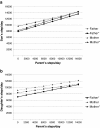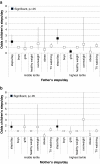Relationship between parent and child pedometer-determined physical activity: a sub-study of the CANPLAY surveillance study
- PMID: 23331386
- PMCID: PMC3663819
- DOI: 10.1186/1479-5868-10-8
Relationship between parent and child pedometer-determined physical activity: a sub-study of the CANPLAY surveillance study
Abstract
Background: Understanding parental influences on their children's physical activity (PA) provides insight into developing effective family-based interventions. This study examines whether children's objectively monitored PA is associated with that of their parents.
Methods: Participants (children and parents) were recruited to a sub-study of the Canadian Fitness and Lifestyle Research Institute's annual Canadian Physical Activity Levels among Youth (CANPLAY) surveillance study. In total, 539 of 1,187 eligible children (age range 5-19 years) and at least one of their parents participated. Participants logged pedometer steps for 7 days. Descriptive statistics were used to examine parental mean daily steps by their children's age, sex and steps/day. Associations between steps/day for parents and children (controlling for their age and sex) were estimated using general linear and logistic regression.
Results: Children's mean steps/day did not differ by parents' age or sex, nor by whether one or both parents participated in the study. There were quantifiable relationships between parents' and children's steps/day. For every 1,000 step increase in a father's steps/day, his son's increased by 329-407 steps/day and his daughter's increased by 273 steps/day (adjusted model only). Every 1,000 step increase in a mother's steps/day was associated with 263-439 extra steps/day for her son's steps/day and 195-219 steps/day for her daughter. A 3,000 step increment in a father's or mother's steps/day was associated with 1.9-2.5 fold increase in the odds that their child's activity level would be in the upper two tertiles of steps/day.
Conclusions: These cross-sectional data indicate that children's PA is related to that of their parents in distinct and quantifiable ways. Interventions are warranted to evaluate the direction of this relationship, confirm the magnitude of influence, and illuminate mediating and moderating mechanisms by which both parents may have influence over their own children's PA.
Figures



Similar articles
-
Canadian children's and youth's pedometer-determined steps/day, parent-reported TV watching time, and overweight/obesity: the CANPLAY Surveillance Study.Int J Behav Nutr Phys Act. 2011 Jun 25;8:66. doi: 10.1186/1479-5868-8-66. Int J Behav Nutr Phys Act. 2011. PMID: 21702982 Free PMC article.
-
A cross-sectional study of the relationship between parents' and children's physical activity.BMC Public Health. 2016 Oct 28;16(1):1129. doi: 10.1186/s12889-016-3793-3. BMC Public Health. 2016. PMID: 27793153 Free PMC article.
-
Health-related parental indicators and their association with healthy weight and overweight/obese children's physical activity.BMC Public Health. 2018 May 31;18(1):676. doi: 10.1186/s12889-018-5582-7. BMC Public Health. 2018. PMID: 29855285 Free PMC article.
-
Objectively measured physical activity in population-representative parent-child pairs: parental modelling matters and is context-specific.BMC Public Health. 2018 Aug 17;18(1):1024. doi: 10.1186/s12889-018-5949-9. BMC Public Health. 2018. PMID: 30119661 Free PMC article.
-
[Simple obesity in children. A study on the role of nutritional factors].Med Wieku Rozwoj. 2006 Jan-Mar;10(1):3-191. Med Wieku Rozwoj. 2006. PMID: 16733288 Review. Polish.
Cited by
-
Are the Parents' and Their Children's Physical Activity and Mode of Commuting Associated? Analysis by Gender and Age Group.Int J Environ Res Public Health. 2020 Sep 20;17(18):6864. doi: 10.3390/ijerph17186864. Int J Environ Res Public Health. 2020. PMID: 32962197 Free PMC article.
-
"We are all gonna get diabetic these days": the impact of a living legacy of type 2 diabetes on Hispanic young adults' diabetes care.Diabetes Educ. 2014 Sep-Oct;40(5):648-58. doi: 10.1177/0145721714535994. Epub 2014 May 27. Diabetes Educ. 2014. PMID: 24867918 Free PMC article.
-
Are children's activity levels determined by their genes or environment? A systematic review of twin studies.Prev Med Rep. 2015 Jun 16;2:548-53. doi: 10.1016/j.pmedr.2015.06.011. eCollection 2015. Prev Med Rep. 2015. PMID: 26844116 Free PMC article. Review.
-
The Influence of Physical Exercise on Adolescent Personality Traits: The Mediating Role of Peer Relationship and the Moderating Role of Parent-Child Relationship.Front Psychol. 2022 Jun 10;13:889758. doi: 10.3389/fpsyg.2022.889758. eCollection 2022. Front Psychol. 2022. PMID: 35756276 Free PMC article.
-
The contribution of physical and sports education to health education of Moroccan middle school students: Representations and practices of teachers.J Educ Health Promot. 2021 May 31;10(1):201. doi: 10.4103/jehp.jehp_1021_20. eCollection 2021. J Educ Health Promot. 2021. PMID: 34250135 Free PMC article.
References
-
- Loucaides CA, Jago R. Correlates of pedometer-assessed physical activity in Cypriot elementary school children. J Phys Act Health. 2006;3:267–276. - PubMed
Publication types
MeSH terms
LinkOut - more resources
Full Text Sources
Other Literature Sources

